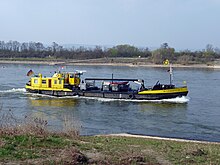Bilge de-oiler
A bilge de- oiler is a ship that collects and disposes of oil waste from motor ships , especially in inland shipping . The main task is to pump out the oily bilge water. The bilge water is a water-oil mixture from the so-called bilge. The bilge water is then separated into water and waste oil directly on the bilge drainer. After filtering, the water is fed back into the river water, while the used oil is collected in tanks and later delivered to disposal points for environmentally friendly disposal.
Systems on board seagoing vessels that treat bilge water in accordance with legal requirements are also referred to as bilge de-oilers. The clear water with a residual oil content of max. 15 ppm (in some specific protection zones also 5 ppm according to IMO -Resolution MEPC.107 (49)) can be discharged into the sea, while the sludge with either heavy oil in the engine is burned or on land as hazardous waste must be disposed of.
In today's most successful process for oil separation, the bilge water is sucked into a container filled with an oleophilic fabric by an eccentric screw pump . Small drops of oil stick to the tissue and coalesce to form large drops, which rise to the top of the container due to the difference in density . As soon as a certain amount of oil has accumulated there, a drain valve is opened and the sludge is pushed out.
The clear water is drawn off in the lower area by the eccentric screw pump and analyzed in a calibrated measuring device. If the water falls below the limit value, it is directed outboard. If the limit value is exceeded, the water is passed through a second stage with adsorbers , analyzed again and either pumped out of the ship or recirculated into the bilge.
Depending on the amount of bilge water or the size of the ship, de-oilers with capacities between 0.1 and 10 m³ / h are available.
Inland shipping
Seven bilge de-oilers are used on the Rhine , Main , Mosel , Neckar , the adjoining canals and on the Danube , including bilge de-oiler 10 . In addition to bilge water, these boats also collect used oil, oil contaminated waste such as cleaning rags, used oil filters and empty oil containers. The bilge water is filtered on board the boats, the purified water is returned to the outboard. The boats are used according to the schedule.
The bilge drainage association founded in 1965 also offers a number of stationary waste disposal companies, pontoons and disposal by road vehicles. About the Convention on the Collection, Delivery and Acceptance of Waste in the Rhine and Inland Navigation (CDNI; Convention relative a la collecte, au depôt et a la reception des dechets survenant en navigation Rhenane et intertieure) between the states of Belgium, Germany and France , Luxembourg, the Netherlands and Switzerland, international compensation is regulated. Since January 1, 2011, it has been financed through taxes on refueling fuel exempt from mineral oil tax (i.e. also government ships, not ocean-going vessels), which is credited to a CDNI -ECO account using ECO cards.
Web links
Individual evidence
- ↑ IMO MPEC. 107 (49). (No longer available online.) Formerly in the original ; Retrieved on April 23, 2010 : "Revised guidelines and specifications for pollution prevention equipment for machinery space bilges of ships"
- ↑ Bilgentölungsgesellschaft Duisburg ( Memento of the original from June 22, 2006 in the Internet Archive ) Info: The archive link was automatically inserted and not yet checked. Please check the original and archive link according to the instructions and then remove this notice.
- ↑ Website of the Central Commission for Navigation on the Rhine (CCNR) and the contracting states to the CDNI and its implementing provisions
